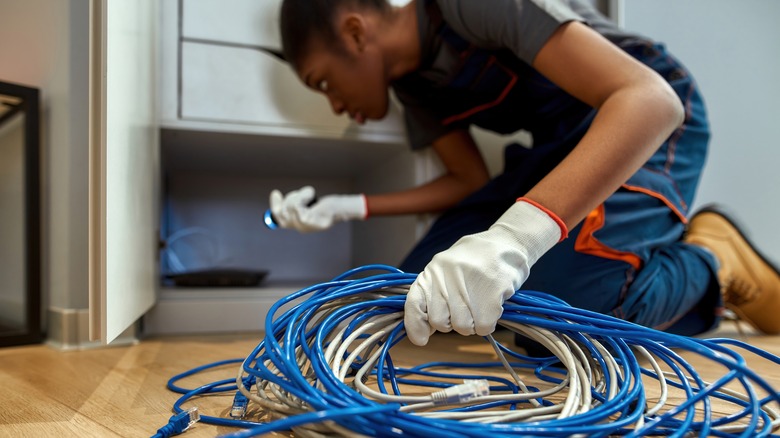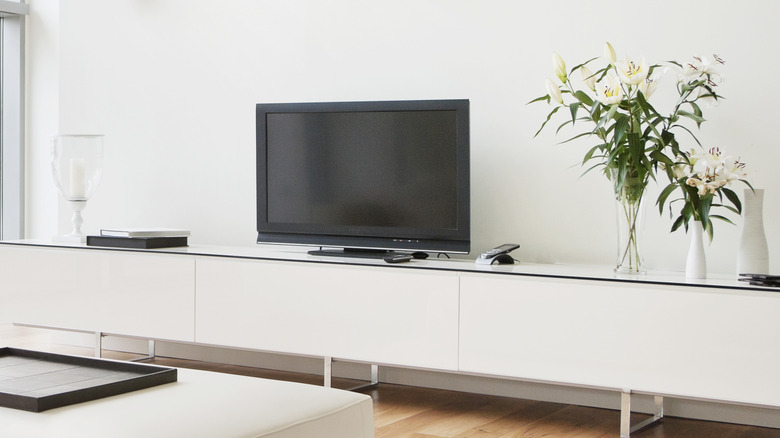Why You Probably Shouldn't Put Your Wi-Fi Router In These Places
A slow internet connection can turn the simplest tasks, like checking email or browsing the web, into a frustrating ordeal. But before you call your internet service provider to upgrade plans or purchase a new router, you'll want to make sure that your existing wireless router is in an optimal location, or at least not in a bad one. Even if a professional installed it, you may need to adjust its position to make sure it's in a more centralized location, where the signal won't be obstructed.
Everything from electrical interference to mount height can affect your connection. Realistically, the absolute best locations for your router may not be viable if your hookup is in a bad location or if the wires clash with your decor, which is okay. But on the other hand, there are definitely places in your home where you'll want to avoid setting up your wireless router at all costs.
Inside a cabinet or drawer
It might be tempting to stash a wireless router in a drawer or cabinet, where it'll remain hidden from view. In reality, that's a bad idea for a couple of reasons. Tucking it away will block the antennas' line of sight, which TechTarget defines as "the direct path from a transmitter to the receiver and the obstructions that may fall in that path." Placing additional obstacles, such as a cabinet door, in the line of sight will weaken the overall signal, causing spotty reception throughout your home.
Another drawback to keeping your router in an enclosed area is that it won't be well-ventilated. Preventing air from circulating around your router's vents will result in a device that consistently runs hot and could even reach the point of overheating. A router that frequently overheats is going to fail well before one that operates at a normal temperature. Therefore, it's best to leave your wireless router out in the open and if you really want to be proactive about heat prevention, the vents can be dusted or blown out with compressed air periodically.
Near to a television or other appliances
If you're considering hiding a wireless router behind a television, please don't. Behind the television is about the worst possible location for a router because the metallic components inside the television will block the antennas' signal even more so than homebuilding materials such as wood, drywall, or masonry.
Besides merely blocking the router's signal, televisions are also capable of generating Electromagnetic Interference (EMI), especially those that aren't properly shielded. Since EMI can wreak havoc with wireless routers, a good rule of thumb is to place them a minimum of five to six feet from any other electronics or appliances, including televisions. While a distance of five or six feet may not be practical for all households, just keep them as far apart as you can.
Microwave ovens are even worse than televisions when it comes to interference because they work on the same 2.4 GHz frequency as some Wi-Fi networks. Wi-Fi equipment that operates on the 5 GHz band shouldn't be affected by microwave oven usage, but the range of 5 GHz Wi-Fi is shorter. It's probably best practice to avoid placing a router near a microwave in any case.
Next to a window or on the ground
Wireless routers transmit an omnidirectional signal that would look like a circle if it was visible. This means that putting your router near a window basically wastes half the signal by broadcasting it outside. Even if not near a window, simply putting a router in a corner of your house or apartment means that a significant amount of its signal may be wasted.
Generally speaking, the more centrally that you can place your router in a dwelling, the better your coverage will be. Besides that, you can potentially avoid hackers nefariously accessing your Wi-Fi to collect sensitive information if your connection can't be picked up outside your house. If your location is limited because of available network connections, a long ethernet cable might prove to be a good investment.
Lastly, routers normally spread their signals downward, so mount your router as high as reasonably possible for the best coverage. A distance of five to seven feet off the ground is ideal, but at a minimum, you should keep it at least a few feet off the ground, like on a table, desk, or bookshelf. A downward signal path is also why you shouldn't put your router in a basement, assuming that your home has one.



